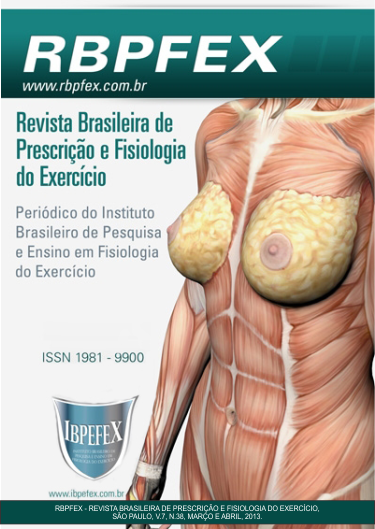Comparison between two techniques of regional sweat collection during exercise in the heat
Abstract
Introduction: The evaluation of sweat electrolyte concentration was originally used to cystic fibrosis diagnoses. Recently, this evaluation has been used to determine athletes’ electrolyte losses during exercise in the heat. For those determinations, the sweat is usually collected by two techniques: filter paper and patches. Objective: To compare both techniques of sweat collection regarding sweat volume and sweat sodium [Na+] and chloride [Cl-] concentrations. Materials and Methods: Eleven adolescents, nine boys and two girls, took part in this study. The sweat was collected simultaneously by the two techniques. The patches and the filter paper were placed on both sides of the dorsal region. Participants cycled in the heat (35°C and 60% RH) of a climaticchamber for 30 min at 50 to 60% of their predetermined maximal workload. Sweat volume was determined by the changes in both patches and filter papers after the exercise in the heat session. Sweat [Na+] was determined by flame photometry and sweat [Cl-] bycolorimetric assay. Results: The sweat volume absorbed by the patches was higher than that absorbed by the filter paper: 0.51 ± 0.196 ml e 0.37 ± 0.013 ml (p<0.05), respectively. Sweat [Na+] was significantly higher in the filter paper, 54.2 ± 21.6 mEq/l, than that in the patches, 42.5 ± 16.9 mEq/l (p<0.05). Sweat [Cl-] was also higher in the filter paper, 53.7 ± 20.2 mEq/l, than that in the patches, 38.7 ± 17.9 mEq/l (p<0.05). Conclusion: The patches seemed to be more adequate for sweat collection duringexercise due to the increased absorption and for showing a sweat [Na+] and [Cl-] closer to those reported in the literature.
References
-Borg, G. A. Perceived exertion: a note on "history" and methods. Medicine and Science in Sports, Volume. 5, Num. 2. 1973. p. 90-93.
-Boysen, T. C.; Yanagawa, S.; Sato, F.; Sato, K. A modified anaerobic method of sweat collection. Journal of Applied Physiology. Volume. 56. Num. 5. 1984. p. 1302-1307.
-Calvert, R.; Bar-Or, O.; Meyer, F.; Falk, B. A modified, disposable and reliable sweat collection device for use in adults and children during exercise in the heat. Medicine and Science in Sports. Volume. 22. Num. S89 1990 p. 234.
-Falk, B.; Bar-Or, O.; MacDougall, J.D.; McGillis, L.; Calvert, R.; Meyer. F.; Sweat lactate in exercising children and adolescents of varying physical maturity. J Appl Physiol Volume. 71. Num. 5. 1991. p. 1735-1740.
-Gibson, L. E.; Cooke, R. E. A test for concentration of electrolytes in sweat in cystic fibrosis of the pancreas utilizing pilocarpine by iontophoresis. Pediatrics. Volume. 23. Num. 3. 1959. p. 545-549.
-Howley, E.; Franks, E. Health fitness instructor handbook. 3rd ed. USA: Human Kinetics; 1997 p. 138.
-Kirk, J. M. Inconsistencies in sweat testing in UK laboratories. Archives of Diseases in Childhood. Volume. 82. Num. 5. 2000. p. 425-427.
-Laitano, O.; Martins, J.; Mattielo, R.; Perrone, C.; Fischer, G.; Meyer, F. Sweat electrolyte loss in asthmatic children during exercise in the heat. Pediatric Exercise Science. Volume. 20. Num. 2. 2008. p. 121-128.
-Mackay, R.; George, P.; Kirk, J. Sweat testing for cystic fibrosis: A review of New Zealand laboratories. Journal of Paediatrics and Child Health. Volume. 42. Num. 4. 2006. p. 160-164.
-Maughan, R. J.; Shirreffs S. M.; Merson S. J.; Horswill, C. A. Fluid and electrolyte balance in elite male football (soccer) players training in a cool environment. Journal of Sports Science. Volume. 23. Num. 1. 2005. p. 73-79.
-Meyer, F.; Bar-Or, O.; MacDougall, D.; Heigenhauser, G. J. Sweat electrolyte loss during exercise in the heat: effects of gender and maturation. Medicine and Science in Sports and Exercise. Volume. 24. Num. 7. 1992. p. 776-781.
-Meyer, F.; Bar-Or, O. Fluid and electrolyte loss during exercise. The paediatric angle. Sports Medicine. Volume. 18. Num. 1. 1994. p. 4-9.
-Meyer, F.; Laitano, O.; Bar-Or, O.; McDougall, D.; Heigenhauser, G. J. Effect of age and gender on sweat lactate and ammonia concentrations during exercise in the heat. Brazilian Journal of Medical and Biological Research. Volume. 40. Num. 1. 2007. p. 135-143.
-Palacios, C.; Wigertz, K.; Martin, B.; Weaver, C. M. Sweat mineral loss from whole body, patch and arm bag in white and black girls. Nutrition Research. Volume. 23. Num. 3. 2003. p. 401.
-Patterson, M. J.; Galloway, S. D.; Nimmo, M. A. Variations in regional sweat composition in normal human males. Experimental Physiology. Volume. 85. Num. 6. 2000. p. 869-875.
-Shirreffs, S. M.; Maughan, R. J. Whole body sweat collection in humans: an improved method with preliminary data on electrolyte content. Journal of Applied Physiology. Volume. 82. Num. 1. 1997. p. 336-341.
-Shirreffs, S. M.; Sawka, M. N.; Stone, M. Water and electrolyte needs for football training and match-play. Journal of Sports Science. Volume. 24. Num. 1. 2006. p. 699-707.
-Vimieiro-Gomes, A. C.; e colaboradores. Comparison of sweat rate during graded exercise and the local rate induced by pilocarpine. Brazilian Journal of Medical and Biological Research. Volume. 38. Num. 7. 2005. p. 1133-1139.
Authors who publish in this journal agree to the following terms:
- Authors retain the copyright and grant the journal the right of first publication, with work simultaneously licensed under the Creative Commons Attribution License BY-NC which allows the sharing of the work with acknowledgment of the authorship of the work and initial publication in this journal.
- Authors are authorized to enter into additional contracts separately for non-exclusive distribution of the version of the work published in this journal (eg, publishing in institutional repository or book chapter), with acknowledgment of authorship and initial publication in this journal.
- Authors are allowed and encouraged to post and distribute their work online (eg, in institutional repositories or on their personal page) at any point before or during the editorial process, as this can bring about productive change as well as increase impact and impact. citation of published work (See The Effect of Free Access).






